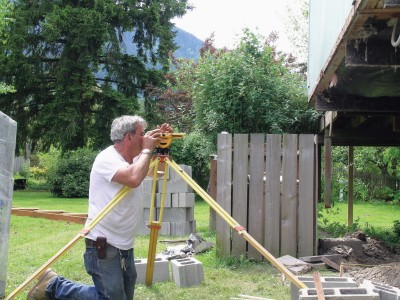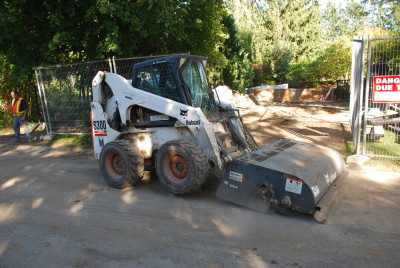Obtain assignment goals and increase profits with planning
by Sally Bouorm | January 1, 2011 11:21 am
 [1]
[1]By Barry Justus
Residential projects under $2 million make up the vast majority of aquatic construction projects in North America. No matter the project’s size, however, most contractors naturally engage in some type of informal site setup and project management. The facilitation of planning, scheduling and controlling activities to meet project goals improves organization and co-ordination, while also allowing builders to make better decisions. Furthermore, a well-prepared systematic approach provides builders with the opportunity to catch, or even avoid problems early on, resulting in higher profits and satisfied clients.
Plan from start to finish
 [2]
[2]A pool builder’s job starts long before he/she starts digging, and ends only on successful closure of the project. As such, detailed plans are not only necessary during construction, but also to successfully bid on a job. The time spent preparing for a project—long before arriving on site—will pay off large dividends in time and profit. Site plans should detail the following:
- Access routes;
- Material/equipment storage, construction/crew parking and site trailer;
- Hazards (e.g. gas lines, over head utilities, sewers, slopes, soil conditions, electrical lines, water lines, etc.);
- Safety (e.g. temporary site fencing, fuel storage, first aid equipment, fire extinguishers, hoarding [tree preservation], silt fences, portable toilets, etc.);
- Elevations, drainage patterns, setbacks, utility corridors, easements and rites of passage;
- Electrical/water access and locates;
- Sprinkler shut off (before construction); and
- Construction details (e.g. concrete, decks, plumbing, irrigation, lighting, drainage, audio, gas lines, electrical and landscape plan).
Detailed site photographs, including pictures of access points, roads, curbs, sidewalks, buildings and neighbouring structures, need to be taken. All angles of the overall site should be included and updated on a regular basis as the project progresses. Not only are these photographs needed for planning purposes, but also for documenting the project’s progress. Photos can also be used to protect the builder in the event of future problems or legal issues with inspectors, clients and subcontractors.
Review legalities
 [3]
[3]Contracts should define the project’s scope, define liabilities and allow for changing contingencies as the job progresses. At this point, all licenses, permits, liability/workers compensation insurance for all contractors working on the project should be reviewed and completed.
Site conditions, geo-technical surveys and structural engineering services are all part of the pre-construction ritual. All necessary permits—including local building code requirements, electrical authority, municipal fees, curb deposits and bonds—must be posted. Forestry hoarding, conservation authority, park access, on-street parking permits, neighbour access rights and various municipal code requirements must all be adhered to throughout the length of the project. Many municipalities require a pre-site construction inspection of all curbs, sidewalks and roadways, while historical societies may limit materials, construction and designs. Depending on the time of year, builders may also face road use weight restrictions, which could impact excavated fill removal and the import of concrete aggregates and construction materials.
Pre-construction formalities
An onsite pre-construction meeting amongst all parties involved in the project—including the architect, landscape designer, structural engineer, project manager, subcontractors and client—should be held. This meeting will serve to review the plan and establish relationships, form alliances and co-ordinate the roles each party will execute.
Part of the pre-construction process is to inform the client of what they can expect, as most have no idea how a large construction project can impact their daily life. In addition to fulfilling the client’s expectations, builders should inform neighbours about the project as well. This can be done by distributing a letter around the neighbourhood, prior to construction, to let neighbours know what to expect as well. By not leaving them in the dark, they are more apt to be courteous, rather than apprehensive, about the project. Information in the letter should include:
- Project scope;
- Projected timelines, including work schedule hours;
- Information on permits, liability insurance, reputation of contractors and licenses;
- Evidence of adherence to municipal bylaws;
- Assurance of conflict resolution;
- Emergency contact numbers, including the site supervisor’s cellphone number;
- Website and e-mail addresses;
- Acknowledgement of their role in the project;
- Thanks for their patience and understanding; and
- Details regarding site safety and site and road clean up (daily and upon project completion).
Site preparation and operation
It is much easier, safer and ultimately more profitable for all concerned to operate a professional site. For example, installing temporary steel fencing not only acts as a safety barrier, deterring theft of construction and pool equipment, it also portrays the company in a professional light. A lock on the access gate prevents unauthorized entry and limits liability. Site fences also provide an ideal location to post marketing signs, permits and contact/safety information.
Site preparation can also include the hoarding of both private and city-owned trees. A thick bedding of mulch, covered with steel plates and combined with fencing around trees, will ensure they survive the construction process. Many municipalities are rigid in their enforcement of tree protection, requiring hoarding, permits and bonds.
Site access often involves entry onto neighbouring properties. Municipalities often require a letter signed by the neighbour allowing access for the duration of the project. It is in a builder’s best interest to do everything in its power to prevent damage to the clients’ and neighbours’ property. Gravel access roads, covered with steel plates, prevent damage to foundations from repeated heavy equipment access. Less dirt and mud is transported onto the city streets when proper right-of-way access corridors are established. Streets will need to be swept of dust and debris on an as required basis. Water trucks can also be employed to minimize dust and clean up the roadway.
Project timelines
Successful site preparation is just one component of overall project management. With today’s web-savvy clients, residential projects are becoming increasingly complex with the demand for more elaborate aquatic features, better quality and materials and shorter time frames for completion.
Optimism should not be the cornerstone of project management—realism is essential. Deadlines that only look good on paper to the customer and trades only set the project up for failure, which can impact the relationships between everyone on the job, resulting in frustrated clients.
The project’s scope should detail all the activities involved, including the duration of those activities, sequencing, timelines, resource allocation (both physical and people) and budget constraints.
Changes in the project’s scope are normal and can be expected, as design modifications may be contractor- or client-driven. Site conditions may also change due to unexpected ground obstructions or extreme weather conditions, while material changes may be the result of design or availability. As the scope changes, design drawings, ‘as built drawings’ and contractual agreements will also have to be modified.
Changes will result in delays in the critical path of the project. Updating the tasks and progress of all parties involved is key to successful project management. Communication via e-mail, site meetings, phone or software scheduling programs are all vital to keeping everyone informed. Computer programs such as Microsoft Project and other open source software allows builders to track and plan projects sufficiently to accommodate all changes in time, cost, scope and quality.
Safety on the site
Site safety includes access to first aid and eye wash stations, readily accessible Material Safety Data Sheets (MSDS), fire extinguishers, areas for safe storage of flammable materials and potable drinking water. All employees, subcontractors and visitors should also be required to wear appropriate safety gear.
Underground utilities can be located by either a private or public agency. In all cases, ‘Call before you dig.’ Public utility locates will not detect private gas lines, sprinklers, water lines, sewers and right of way easements. All of these hazards must be located, documented and spray painted or flagged.
The actual construction site should be spray painted and staked. All structural elements, (e.g. decks, landscape boundaries, plumbing chases, drain/gas/electrical lines, irrigation, trenches and grades) should be established as per the plan. A copy of the site plan should also be posted and made available to all interested parties.
Site necessities
 [4]
[4]A portable toilet should be the first item delivered to the site, and the last to leave. A quality submersible pump should also be on hand to keep the excavation free of standing water, by evacuating it to a suitable location. Silt barriers erected around the site perimeter should prevent run off from disturbing adjacent waterways, swales and neighbouring properties.
A large garbage container, along with numerous smaller waste bins, should be available to keep the job site safe and tidy. Recycling bins should also be available, as they are environmentally responsible and good for site image.
Finally, plastic or landscape fabric is a simple and cost-effective way to protect houses and plantings from having to scrape or power wash concrete and other construction debris. This type of protection pays back quick dividends in public relations and final project settlement.
Proactive vs. reactive project management
Proactive management is preferred, as it allows builders to be better organized and co-ordinated, while reactive management involves reacting to events and constantly dealing with problems.
All project management methods, however, revolve around time, quality, cost and scope. The interrelationship between these variables can not be avoided. Better quality will generally cost more and take longer. If the client wants the project completed faster, builders will have to sacrifice quality, scope or cost.
Cost control
Time and cost estimates have to be both realistic and adjusted throughout the duration of the project. Client feedback is imperative, along with constant updates to all subtrades and suppliers. New requirements and additions to the scope of the project will necessitate the commitment of more resources, time, material and costs.
Quality workmanship
The project manager’s job is to lead, organize, plan, control, implement, evaluate and maintain the objective. The initial team meeting should review the entire plan to establish the overall goal.
At this stage, the roles of all players need to be firmly agreed upon. The role of the project manager is to encourage, be positive and look at the big picture, while also paying attention to the details. A reputation of ‘doing what you say, when you say’ goes a long way. Simple courtesies, such as returning phone calls and e-mails promptly, allow the project to progress smoothly. When trades can rely on the builder’s scheduling abilities, they will show up with the knowledge that everything is ready for them to complete their portion of the project.
Project consummation
 [5]
[5]Upon project completion, everything must be reviewed to verify all project goals and contract obligations were met. The way a builder finishes a project and finalizes the details is the last impression they leave on clients and their neighbours. A deficiency list or punch ticket needs to be produced. Site clean up, including final inspections, system startup and careful review of all project elements, is key.
Bonds must be released, warranties reviewed and final site photographs produced. Sign offs from inspectors, neighbours, clients, subtrades and crew leaders ensure all parties involved are satisfied with the end result.
A well-run, organized, professional project is a difficult undertaking. Any fees earned for project management are deserved and well worth the additional cost to the client. The end result of a successfully managed project is extremely satisfied customers. This directly impacts referral rates, sales and profits, which are all great reasons for more builders to start planning, implementing, reviewing and managing more of their aquatic environment projects.
 Barry Justus is the owner of Poolscape Inc., a landscape contractor and pool designing and building company based in Burlington, Ont. He can be reached at barry@poolscape.com[6] or by visiting www.poolscape.com[7].
Barry Justus is the owner of Poolscape Inc., a landscape contractor and pool designing and building company based in Burlington, Ont. He can be reached at barry@poolscape.com[6] or by visiting www.poolscape.com[7].
- [Image]: http://poolspamarketing.com/wp-content/uploads/2011/01/Poolscape-site-5.jpg
- [Image]: http://www.poolspas.ca/wp-content/uploads/2015/07/BS_6407714.jpg
- [Image]: http://www.poolspas.ca/wp-content/uploads/2015/07/BS_565949.jpg
- [Image]: http://www.poolspas.ca/wp-content/uploads/2015/07/Poolscape-site-9.jpg
- [Image]: http://www.poolspas.ca/wp-content/uploads/2015/07/Poolscape-site-8.jpg
- barry@poolscape.com: mailto:barry@poolscape.com
- www.poolscape.com: http://www.poolscape.com
Source URL: https://www.poolspamarketing.com/trade/obtain-assignment-goals-and-increase-profits-with-planning/